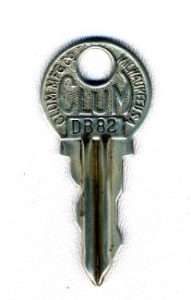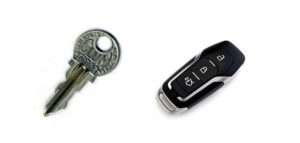Henry ford produced the first ever ford car on this day in history 16th June 1903. Ford keys have evolved in many ways since they were first introduced. What started as a simple manual mechanical key is now a highly sophisticated device that utilises more technology than ever before. If you went back in time to 1908 and told a Ford driver they could start their car with the push of a button you would have most likely been drowned for believing in witchcraft.
Forward on over 100 years and Ford owners have the ability to unlock their car remotely and manage individually defined comfort settings linked to their key. The added technology and control embedded into Ford car keys has seen the cost of buying a replacement car key rocket through the roof. A recent car key prices report reveals that new Ford keys can cost as much as £230. Perhaps the simple old mechanical keys from the early 19th century were better after all?
Checkout KeyReaper for the everyday spinner that lives on your keychain.
Ford Car Keys in History

Henry Ford produced the first ever Ford car in 1908, known as the Ford Model T. Right up until the end of production in 1927 the Model T used a few variations of a simple metal key.
One of the earliest Ford keys noted was given the factory number T-5815. The T-5815 keys were made of three separate pieces that had a brass plated handle. These keys would have been supplied by either K.W Ignition Co or Clum Manufacturing Co.
In 1916 came the first change to these keys, with the switch from a brass plate finish to a new rust free finish known as a Raven finish, which left a dark phosphate coating on the key. One year later the key was changed from three pieces to a single steel key, which would have been known as a “Switch Key”, eventually taking an updated name of T-5815-A.
In 1919 the key head was changed to a diamond shape and would have been manufactured by around five different vendors. The head would have been pin frosted with the word “Ford”, and under this the vendors trademark would have also been etched. The following five companies were involved with the production:
Briggs and Stratton Co.
Cabkey Dupree Co
Clum Manufacturing Co.
King Lock Co.
Culver Stearns Co.
One year on in 1920 the vendors name was removed, leaving just “Ford” and the serial number etched in one side, with the other side now totally smooth.
1926 saw another change to the key with the material being changed from nickel to brass.
The next big change to the Ford key came in the late 1980’s with the introduction of the Ford Tibbe key. The Tibbe key first used on the Merkur Scorpio was cylindrical in appearance with 6 cuts ranging from 1 to 4 in depth.
The Tibbe key ran right up to 2013 where it was last used on the Ford Transit and Transit Connect. In 2004 most other models of Ford saw a brand new and much more secure key known as the HU101 profile key. This laser type key has a track milled down the side and has 10 cuts ranging from depths 1 to 5.
The HU101 key is much more secure than the Tibbe key and lock, which was prone to picking by thieves. The HU101 profile keys are still used on most Ford models today, with the exception of the Ford Fiesta which is now using a HU162T profile key. This key blade is the same shape as the HU101 key blade, but is milled straight through the middle and has different space and depths.
Ford key technology

Over the years Ford keys have evolved with ever increasing amounts of technology. The first real change in terms of technological advancements was the inclusion of a remote locking device attached to the head of the Tibbe style keys. The remote fob part of the key has either 2 or 3 buttons and allows the driver to remotely lock and unlock the car.
In 2007 Ford made waves with a very intelligent smart key that enables drivers to not only unlock their car at the push of a button, but also start the car by pushing a button on the dash. This type of key is known as a proximity key and is used on many Ford models today. With advances in technology comes luxury benefits, but also complications and issues if the technology fails. If the battery in the proximity key fails many motorists are unaware how to unlock a Ford when the remote is not working. Fortunately Ford include an emergency key blade hidden in the back of the proximity key for use in these situations.
The styles of Ford proximity key have changed a few times, and there are now four types of proximity smart keys associated with Ford cars.
Which key do you prefer?

About the author
Hey there, i’m Mark Migliaccio owner of The Auto Locksmith. I have over 10 years industry experience as an auto locksmith specialising in car key keys and vehicle diagnostics. When i’m not programming car keys you will find me offering honest expert car key advice over at The Auto Locksmith Help & Advice Hub





